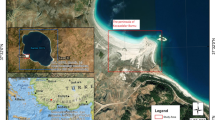Abstract
Near-infrared (NIR) spectral data were obtained from 165 surface sediment samples from a northern Swedish humic, mesotrophic lake (0.5 km2). The NIR spectra, together with data on water depth and loss-on-ignition (LOI), allow an evaluation of the source of spatial variance in sediment characteristics. The results show that water depth and organic matter (LOI) account for 20 and 16%, respectively, of the variance in the NIR-absorbance data. More importantly, the spatial variance in the spectral data suggest that NIR analysis of lake sediments mainly reflect sediment properties that cannot simply be explained by depth or amount of organic matter. The influence of inlets and land-use (e.g. clear-cutting) on sediment characteristics was more pronounced in the spectral data than would be expected from the LOI data. This is explained by differences in the chemical composition of the organic matter, as revealed by NIR spectroscopy, rather than in the amount of organic matter or depth-related sedimentation properties (e.g. particle size or density). This initial attempt to characterise sediment properties using NIR suggests that NIR analysis might become a valuable complementary tool to traditional sediment characterisation.
Similar content being viewed by others
Author information
Authors and Affiliations
Rights and permissions
About this article
Cite this article
Korsman, T., Nilsson, M.B., Landgren, K. et al. Spatial variability in surface sediment composition characterised by near-infrared (NIR) reflectance spectroscopy. Journal of Paleolimnology 21, 61–71 (1999). https://doi.org/10.1023/A:1008027001745
Issue Date:
DOI: https://doi.org/10.1023/A:1008027001745




